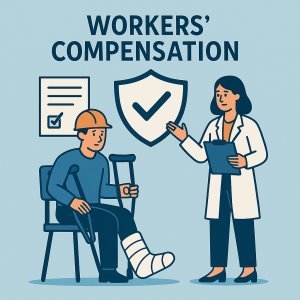
Experience Mod Projection: Anticipate Premium Changes Early
August 16, 2025
Top Technology Investments Cutting Georgia Security Guard Workers’ Comp Claims
August 16, 2025In today’s competitive security industry, effective management of workers’ compensation costs is crucial for maintaining profitability and operational efficiency.Return-to-work (RTW) programs have emerged as a strategic solution,enabling security firms to reduce workers’ comp expenses while promoting employee well-being and retention. By facilitating a structured and supportive pathway for injured security guards to resume duty, these programs not only minimize lost-time claims but also enhance workforce stability. This article explores how well-designed return-to-work initiatives can drive significant cost savings and operational benefits within teh security sector.
Table of Contents
- Benefits of Early intervention in Return-to-Work Programs
- Customizing Work Assignments to Match injury Recovery
- Leveraging Technology for Efficient Case Management
- Strategies for collaborating with Medical Providers and Insurers
- Q&A
- To Conclude
Benefits of Early Intervention in Return-to-Work Programs
Proactive engagement immediately after an incident considerably reduces the duration and cost of workers’ compensation claims. By initiating dialog and tailored support early, security firms can facilitate a faster, safer recovery, minimizing time away from work. This approach not only boosts employee morale but also strengthens employer-employee trust, creating a positive work surroundings that encourages adherence to recovery protocols.
Early intervention programs offer a structured pathway that prioritizes modified duties and gradual reintegration. This minimizes the risk of chronic disability and reduces the likelihood of re-injury. The following table illustrates some key benefits quantified over a fiscal year for security firms implementing early intervention:
| Benefit | Impact on Costs | Return-to-Work Time |
|---|---|---|
| Reduced claim duration | 40% decrease | 10 days faster |
| Lower medical expenses | 30% savings | N/A |
| Decreased lost productivity | 25% gain | N/A |
Customizing Work Assignments to Match Injury recovery
Adjusting job duties to align with an injured security guard’s current physical capabilities not only accelerates recovery but also minimizes downtime costs. This approach involves a detailed assessment of medical restrictions followed by a strategic redesign of tasks to emphasize low-impact responsibilities such as:
- monitoring surveillance feeds from a stationary post
- Conducting access control and visitor log maintenance
- Performing routine inspections that require minimal physical exertion
- Assisting with administrative security documentation
By tailoring assignments, companies retain experienced personnel and reduce the likelihood of reinjury, which frequently enough leads to fewer workers’ compensation claims. Here is a comparison of typical duties before and after injury adaptation to illustrate practical adjustments:
| Pre-Injury Duties | Post-Injury Adapted Duties |
|---|---|
| Patrolling large perimeters on foot | Surveillance monitoring from a control room |
| manually lifting security equipment | Scheduling maintenance and inventory checks digitally |
| Rapid response and physical intervention | Telephone-based incident reporting and coordination |
leveraging Technology for Efficient Case Management
Modern technology transforms traditional workers’ compensation case management by streamlining communication and documentation processes. Cloud-based platforms enable real-time sharing of injury reports, medical records, and rehabilitation plans between security firms, insurers, and healthcare providers. This interconnected approach ensures that all stakeholders are aligned on an employee’s recovery status and return-to-work timeline.Additionally,automated alerts and dashboards reduce administrative delays,enabling quicker decision-making to implement modified duty assignments that keep injured guards productive while healing.
Key technological tools driving efficiency include:
- Mobile apps for instant injury reporting and updates
- AI-driven analytics to predict recovery trajectories and prevent claim disputes
- Virtual physical therapy sessions facilitating continuous care without site visits
- Secure digital forms that expedite approvals for accommodations or treatments
| Technology | Benefit | Impact |
|---|---|---|
| Cloud-based Case Management | Real-time collaboration | 25% faster claim resolution |
| AI Analytics | Predictive injury recovery | 30% reduced claim disputes |
| Tele-rehabilitation | Continuous care access | 20% quicker return-to-work |
Strategies for Collaborating with Medical Providers and insurers
Effective collaboration with medical providers and insurers hinges on establishing open lines of communication that prioritize clarity and shared goals.By implementing regular case review meetings and utilizing secure digital platforms for real-time updates, employers can ensure that everyone remains aligned on the injured worker’s progress and return-to-work timeline. This approach not only expedites approval processes but also facilitates tailored treatment plans that incorporate modified-duty options, reducing unnecessary downtime.
Additionally, creating a structured coordination framework benefits all parties involved. Consider incorporating the following best practices:
- Early intervention protocols to engage providers and insurers immediately after an incident.
- Shared documentation systems that streamline claims processing and reduce paperwork delays.
- joint training sessions to educate medical personnel on workplace-specific job demands and return-to-work possibilities.
- Performance metrics dashboards tracking recovery milestones, claim resolution times, and re-employment rates.
Q&A
Q&A: Return-to-Work Programs That Slash Security Guard Workers’ Comp Expenses
Q1: What are return-to-work (RTW) programs in the context of security guard employment?
A1: Return-to-work programs are structured strategies implemented by employers to facilitate the safe and timely reintegration of injured security guards back into the workforce. These programs often involve modified duties or transitional roles that accommodate the employee’s physical capabilities during recovery, aiming to reduce lost workdays and workers’ compensation claims.
Q2: Why are RTW programs particularly important for security guard companies?
A2: Security guard roles can be physically demanding, exposing employees to risks of injury. Effective RTW programs help mitigate the financial impact of these injuries by minimizing workers’ compensation costs, retaining experienced staff, and maintaining workforce productivity. For security firms, these programs also enhance morale and demonstrate a commitment to employee well-being.
Q3: how do RTW programs contribute to lowering workers’ compensation expenses?
A3: RTW programs reduce workers’ compensation expenses by shortening the duration of claims through early intervention and enabling employees to perform modified or light duties rather than being fully off work.This approach decreases indemnity payments, reduces medical costs by encouraging active recovery, and lowers the likelihood of claims escalating or becoming long-term disabilities.Q4: What are some best practices for implementing a prosperous RTW program in the security industry?
A4: Best practices include: conducting comprehensive injury assessments, developing clear light-duty job descriptions compatible with an injured guard’s capabilities, ensuring strong communication between management, medical providers, and employees, training supervisors on RTW protocols, and continuously monitoring progress to adjust duties as recovery advances.
Q5: Can RTW programs impact insurance premiums for security guard companies?
A5: Yes. By effectively managing claims and reducing the frequency and severity of injuries through RTW initiatives, security companies can demonstrate reduced risk to insurers. This frequently enough translates into lower workers’ compensation premiums and potential eligibility for safety and loss prevention-related discounts.
Q6: What challenges might security firms face when adopting RTW programs, and how can they overcome them?
A6: challenges include limited suitable light-duty tasks, employee resistance to returning prematurely, and logistical issues in coordinating with healthcare providers. Overcoming these obstacles requires creative role adaptation, obvious communication emphasizing the benefits of early return, and establishing strong partnerships with medical professionals to ensure appropriate recovery timelines.
Q7: How measurable are the financial benefits of RTW programs in the security sector?
A7: Financial benefits are measurable through reduced workers’ compensation claim costs,decreased indemnity payments,fewer lost workdays,and lower insurance premiums. Security firms that implement structured RTW programs typically report significant cost savings and improved operational continuity,making such programs a sound investment in risk management.
To Conclude
In today’s competitive security industry, implementing effective return-to-work programs is not just a strategic advantage-it is indeed a necessity. by prioritizing timely, well-structured reintegration of injured security guards, organizations can significantly reduce workers’ compensation expenses while fostering a safer, more supportive workplace environment. these programs not only facilitate quicker recovery and minimize lost workdays but also enhance employee morale and retention. Security firms that invest in comprehensive return-to-work initiatives position themselves to achieve sustained operational efficiency and financial resilience in an increasingly complex risk landscape.
“This content was generated with the assistance of artificial intelligence. While we strive for accuracy, AI-generated content may not always reflect the most current information or professional advice. Users are encouraged to independently verify critical information and, where appropriate, consult with qualified professionals, lawyers, state statutes and regulations & NCCI rules & manuals before making decisions based on this content.







